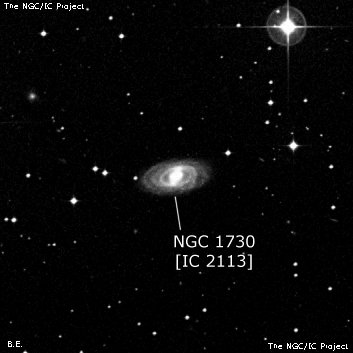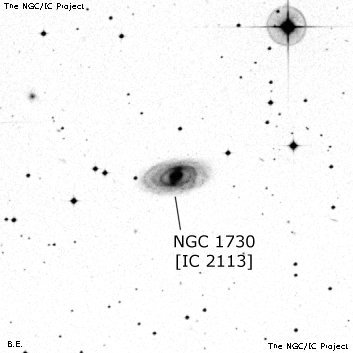NGC/IC Project Restoration Effort
(This is a very very beta version)
NGC1730


Basic Information
Location and Magnitude
Right Ascension: 4:59:31.7
Declination: -15:49:24
Constellation: LEP
Visual Magnitude: 12.3
Historic Information
Discoverer: Leavenworth
Year of discovery: 1885
Discovery aperture: 26.3
Observational
Summary description: F, pS, lE, bet 2 F st (O St D, Δ 10")
Sub-type: SBa
Corwin's Notes
=====
NGC 1730 = IC 2113. This is one of the bright Leander McCormick nebulae that
the Herschels could probably have picked up. However, it was apparently first
seen on 12 November 1885 by Francis Leavenworth. It is one of the rare
nebulae in the first LM list to have more than a single observation, but its
position is still given to only a full minute of time. It is also one of the
few to have two sketches from LM -- the first is Leavenworth's discovery
sketch, the second is by Frank Muller from 16 February 1887. The sketches are
similar, but Leavenworth claims two nebulae, while Muller -- correctly -- has
a nebula with a superposed star. Leavenworth's measurement of the separation
(10 arcsec at PA = 110 degrees) is, however, correct. The star can be easily
seen in the 2MASS image superposed just a few arcseconds northwest of the
nucleus of the barred spiral, within the inner ring.
By the way, the NGC misattributes the object to Ormond Stone rather than to
Leavenworth.
In between the two LM observations which led to the sketches, Lewis Swift
picked up the galaxy on 9 October 1886 and published it in his fifth list of
new nebulae from Warner Observatory in Rochester, NY. His position for the
galaxy is one of the best he ever published, falling just a few arcseconds
from the nucleus (statistics suggests that this happens now and then).
Fortunately, Dreyer used this position for the NGC.
Well, OK, you say, but what about IC 2113? That was found by Barnard and
is apparently one of the several discoveries that he sent directly to Dreyer.
I find no trace of it in any of his papers on nebulae, at least in those
papers that I've collected. His position for the galaxy is nearly coincident
with Swift's, so I have to assume that neither he nor Dreyer checked the NGC
closely.
Comparison stars for this also figure in the uncertain identifications for
IC 400, which see.
Steve's Notes
=====
NGC 1730
17.5" (12/3/88): fairly faint, fairly small, oval ~E-W. There is possibly an extremely faint star at the east end [verified on DSS]. Forms an obtuse angle with mag 8.7 SAO 150054 5' NW and mag 9.0 SAO 150066 7' ENE.



